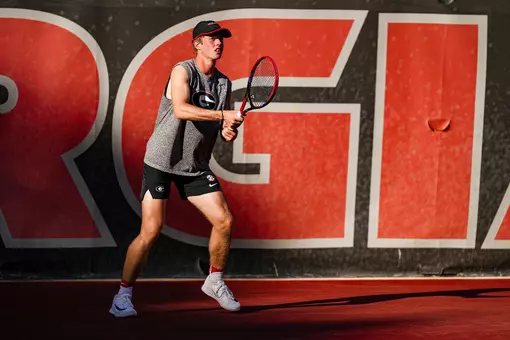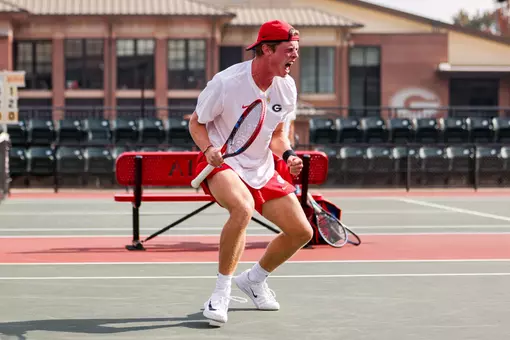University of Georgia Athletics
`Mac' Arrives In Athens
May 25, 2017 | Men's Tennis
By John Frierson
UGAAA Staff Writer
More than a few great collegiate players have gone on to great success and stardom after wrapping up their careers at the NCAA Championships in Athens: John Isner, James Blake and Bob and Mike Bryan are a few more recent examples.
When John McEnroe stepped onto the courts at Henry Feild Stadium in 1978 as a Stanford freshman, he was already a star — already a semifinalist at Wimbledon — and by the end of the year he'd be ranked No. 4 in the world. In more ways than one, we'd never seen anything like him.
All these years later, it will be 40 next May, he's still the biggest star college tennis and likely all of American tennis has ever seen. His talent was that off the charts, his passion that evident and his conduct that, well, compelling, if nothing else.
Stanford was undefeated when it arrived in Athens, with a lineup that may well have won the tournament without McEnroe. The 1977 NCAA singles champion, Matt Mitchell, played No. 3 for Stanford the following year.
The Cardinal was the top seed in the team event and McEnroe the No. 1 seed in singles and doubles (with partner Bill Maze). Stanford coach Dick Gould, who retired with 17 NCAA team championships, said McEnroe wanted to win the NCAAs so badly that he was "tight as a drum during that whole thing."
Gould said McEnroe — "Mac" is how he typically referred to him — had been "a good citizen, so to speak" all season, but the tension began to mount late in the regular season and sparked a tantrum or two. More was to come in Athens. But so was a lot of extraordinary play.
By the time Stanford had won the team title, beating No. 2 seed UCLA, 6-3, in the final, McEnroe had put on a show with his play and his outbursts. Before the singles and doubles began, Gould said he contemplated a big decision.
"I came very close to pulling him out of the tournament, because of the way he was acting," Gould said recently. "I said, this is his tournament and what does it help to pull him out? ... I made the decision to let him keep playing, which I'm glad I did. But on the other hand, I had to make that decision because his actions, they were not right."
McEnroe famously advanced all the way to the semifinals of Wimbledon before enrolling at Stanford. When he got to California and called his coach, Gould jokingly told him: "John, I thought you turned pro — I gave your scholarship away. A little bit of silence and then we both started laughing."
But McEnroe didn't suit up for the Cardinal right away. He'd played a heavy schedule all spring and summer, competing as an amateur in pro events, and Gould told him to take a break.
"I gave him the fall off," he said. "I'd never given a player the fall off before. I said, 'John, I don't want to see you this fall; get settled in school and I'll see you later.' Never done that before; best thing I ever did.
"He needed the time off after playing six straight months as a young kid against the best players in the world."
McEnroe was the best player on an all-time great Stanford team, and college tennis that spring was loaded with tremendously talented players that would go on to success in the pros: UCLA's Eliot Teltscher was ranked as high as No. 6 in the world; Texas' Kevin Curren, the 1979 NCAA singles champion, reached No. 5; USC's Robert Van't Hof, the 1980 NCAA singles champ, reached No. 25 in the world.
McEnroe and Teltscher had played a great match during the regular season in a narrow Stanford victory over UCLA, the closest the Cardinal came to losing a match. Down a match point in the second set, McEnroe hit a running passing shot that Gould called "the best shot under pressure I've ever seen — period," and rallied to win in three sets.
Teltscher was the No. 2 seed in Athens, but there would be no rematch. North Carolina State's hard-serving John Sadri saw to that. The No. 11 seed beat the Bruin in the quarterfinals and then knocked off third-seeded Eddie Edwards of Pepperdine in the semis.
McEnroe's route to the final wasn't easy. In the quarters he won a three-setter against Trinity's Erick Iskersky, the singles finalist the following year. (Personal note: My father, Joe Frierson, was the chair umpire for that match, and during it McEnroe and a vocal spectator got into it a bit, forcing my dad to step in and settle things down.)
In the semis McEnroe faced off against his doubles partner and close friend, Maze. In a tense three-setter, McEnroe prevailed 6-2 in the third. They later lost in the semifinals of the doubles, for obvious reasons, Gould said.
"They had a bit of a tiff in that (singles) match, so they went into the doubles and they essentially played singles with each other in the doubles match," he said. "They weren't talking to each other or anything."
Here's how former Georgia coach and tennis historian Dan Magill described the McEnroe-Sadri match in "Match Pointers," his book on college tennis: "The most exciting NCAA men's singles finals of modern times was the four-hour battle of the Johns, McEnroe of Stanford and Sadri of North Carolina State, in 1978 on the University of Georgia's fast-playing hard-surfaced courts."
Here's how Gould described it: "That match with Sadri was probably the greatest match I've ever seen, in terms of two great warriors battling it out."
McEnroe was already worn out physically after winning the team event and reaching the finals of the singles and semis of doubles, whereas N.C. State had lost early in the team tournament and Sadri had lost in the first round of the doubles, to, coincidentally, McEnroe and Maze.
Sadri, after walking to the court in his customary cowboy hat, put on a serving exhibition. In the four-set match (they played best three out of five in the finals back then), Sadri hit 24 aces and was never broken.
McEnroe was only broken once, in the third set that Sadri won 7-5. The first two and the fourth set went to tiebreakers, with McEnroe winning all three by two points, for a 7-6, 7-6, 5-7, 7-6 victory. When Sadri missed a volley on match point, a worn-out McEnroe looked more relieved to be done than excited about being the NCAA champion.
"He could make shots when it mattered most,'' Sadri told N.C. State's website, gopack.com, in 2010. "(He) had a sixth gear. Everybody else had a fifth gear."
And that maybe sums of McEnroe in 1978 best of all, he had an extra gear that nobody else possessed. And the thousands that packed into the stands to watch, whether they liked him or not, got to see it in person on college tennis' biggest stage.
John Frierson is the staff writer for the UGA Athletic Association and curator of the ITA Men's Tennis Hall of Fame. He's also on Twitter: @FriersonFiles and @ITAHallofFame.




